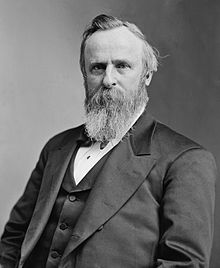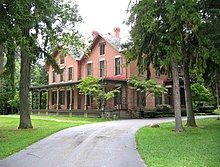About Rutherford B. Hayes
Rutherford Birchard Hayes was born on October 4th, 1822 in Delaware, Ohio. His parents were Sophia Brichard and Rutherford Hayes, Jr. He had a childhood marked with loss, but it was still a happy and somewhat stable one. Hayes went on to become the nineteenth president of the United States from the year 1877 to 1881. He also served as the governor of Ohio and in the U.S House of Representatives.
By profession, Rutherford B. Hayes was a lawyer. He was also known as a staunch abolitionist and defended the rights of refugee slaves in the pre-war years. His background is worth knowing in order to understand the path he took later in life.
Rutherford B. Hayes’ Early Childhood
Rutherford B. Hayes didn’t know his father for very long. The latter was a storekeeper in Vermont. Before Hayes’ birth, his father moved the family to Ohio in the year 1817. This was probably because of the poor economy in New England.
At that time, the couple had two children, Hayes’ elder brother and sister. The family then established a farm as well as a whiskey distillery and even built their own house.
In 1822, just 10 weeks before the future president was born, his father passed away. The couple had also lost their second daughter fairly recently.
Hayes’ Mother
Sophia Hayes was a strong woman despite her losses, and forged ahead to raise her two sons and daughter on her own. She didn’t marry again; however, her brother, named Sardis Brichard, lived with them for some time. He was a kind of father figure to Rutherford B. Hayes while also being a contributor to the child’s early education.
Rutherford B. Hayes was quite prone to sickness in infanthood. While his health did show some improvement when he was two years old, his elder brother (who was nine at the time) drowning in an ice-skating accident. Sophia Hayes had to suffer yet another loss while also taking care of her daughter Fanny and her younger son, who was known as ‘Rud’.
Family Life
While the Rutherford family was no stranger to tragedy, Rud was still able to enjoy a fairly comfortable childhood filled with love and care. Sophia Hayes was independent and active as well as being religious—each of these traits probably helped her to face the hardships in her life.
The children’s uncle, Sardis Brichard, eventually settled in Ohio in Lower Sandusky. While he was absent for the most part, he was still a sort of surrogate father for both Rud and Fanny. Sophia also managed to get by from an income made by taking in lodgers and leasing the farm in exchange for a portion of the crops.
Hayes’ Sibling
Rud’s mother was also quite protective of him, which isn’t surprising given what happened to his brother. Until he was seven years old, Rud wasn’t allowed to play with anyone other than his own family members. He was also not allowed to take part in rough sports until he was nine years old.
These restrictions led to the brother and sister developing a close friendship, playing together, and even taking care of each other when they were ill. It was their mother who taught Rud how to read and write, but Fanny introduced her brother to the poetry of Sir Walter Scott and the plays of Shakespeare among many other things.
Schooling
Both children attended a public district school for some time, which was free for all and even counted young men as its students. However, Hayes later recalled a memory where the schoolmaster threw a knife at a boy who was whispering. Such incidents were probably the reason why public school wasn’t in the cards for Fanny and Rud.
Hayes actually regarded his first teacher to be Joan Hills Murray, who managed a private school in their town. Both Hayes and his sister were hardworking students and their uncle financially helped them gain a private school education.
Rud studied at Norwalk Seminary, Ohio first and then at another private school in Connecticut. He then went to Keyon College was graduated as valedictorian in 1842. Both Sardis and Fanny had very high hopes for Rud, who then pursued a legal career. However, his stint at a Columbus was tedious and vexing, according to himself, and lasted for just ten months.
After this, Hayes entered Harvard Law School, getting his bachelor of laws degree a couple of years later. He then became a part of the Ohio bar and started a practice in his uncle’s town, which was later renamed Fremont.
Courtship and Marriage
As a successful and established lawyer, Hayes did find in the company of many belles in Cincinnati. However, he was most attracted to Lucy Ware Webb, a girl in his own home town. Lucy’s and Hayes’ mother were friends, and Lucy herself was staunchly antislavery just like her parents. In fact, her father had died in Kentucky, where he had traveled in order to free some slaves he had inherited. Lucy’s mother was asked to sell those slaves to support her family. She refused and said that she would prefer to take in washing rather than sell a slave.
Eventually, Lucy and Rutherford B. Hayes got married after a short courtship. The influence from Lucy and her family was probably a strong one when it came to Hayes’ own abolitionist views later on. At this point, though, Hayes didn’t have any lucrative fees coming in. However, his marriage was still a happy one, lasting thirty-six years and producing eight children. Their age of prosperity also began after the wedding.
Congressman and Governor
In the middle of 1864, Hayes’ Republican friends nominated him for the U.S House of Representatives. He was then enlisted in the army and refused to campaign, saying that an officer who was fit to perform his duty should be scalped if he abandoned his post for a Congress seat.
It was this sort of statement that made him more politically effective than any sort of speech. Eventually, he was elected to the Thirty-Ninth Congress. While this was a great success, the congressman’s life had Hayes missing his family. He had only seen them a few times due to the four warring years. In 1867, he resigned to run for the post of governor of Ohio.
This was also the time when he supported the amendment of the Ohio constitution for giving African-Americans the right to vote. his stance was quite unpopular back then. While he did manage to win by a narrow margin, the Democrats controlled the Ohio state legislature, so the voting rights didn’t change. However, Hayes later managed to ensure the ratification of the Fifteenth Amendment. This successfully did away with the racial limitations of voting, though the gender limitations were still in place.
Presidency
The presidency of Rutherford B. Hayes has its controversies, as it was the result of a very close election. Some electoral votes were disputed, but Congress eventually decided to go with Hayes. While the start of the presidency was overshadowed by claims of fraud, Hayes seemed to be genuinely sincere in making things better for his country. He fought for the rights of black citizens, especially in the Southern states. Even after his retirement after just one term, he continued to work on educating the poorer classes and civil rights.
US Presidents | ||




